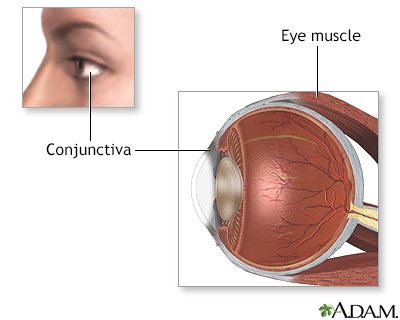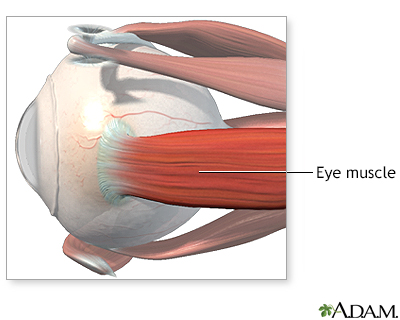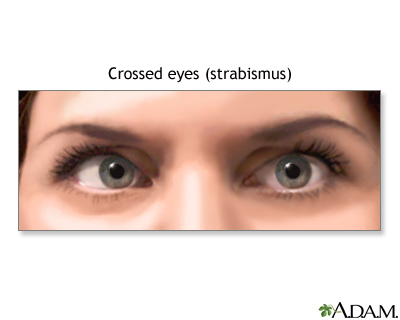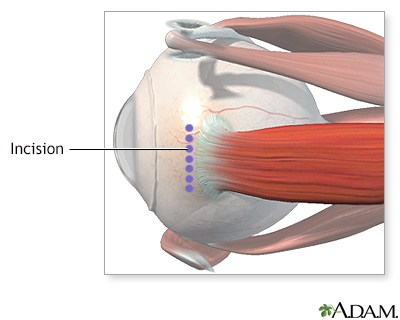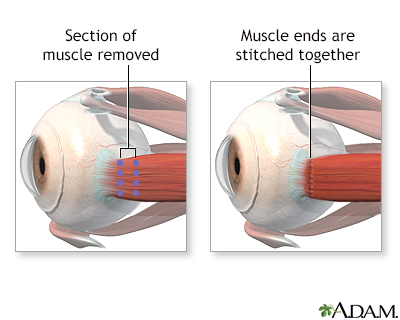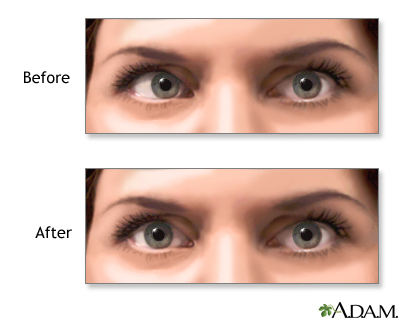Strabismus
Crossed eyes; Esotropia; Exotropia; Hypotropia; Hypertropia; Squint; Walleye; Misalignment of the eyesStrabismus is a disorder in which both eyes do not line up in the same direction. Therefore, they do not look at the same object at the same time. The most common form of strabismus is known as "crossed eyes."
Causes
Six different muscles surround each eye and work "as a team." This allows both eyes to focus on the same object.
In someone with strabismus, these muscles do not work together. As a result, one eye looks at one object, while the other eye turns in a different direction and looks at another object.
When this occurs, two different images are sent to the brain -- one from each eye. This confuses the brain. In children, the brain may learn to ignore (suppress) the image from the weaker eye.
If the strabismus is not treated, the eye that the brain ignores will never see well. This loss of vision is called amblyopia. Another name for amblyopia is "lazy eye." Sometimes lazy eye is present first, and it causes strabismus.
Amblyopia
Amblyopia is the loss of the ability to see clearly through one eye. It is also called "lazy eye. " It is the most common cause of vision problems i...

In most children with strabismus, the cause is unknown. In more than one half of these cases, the problem is present at or shortly after birth. This is called congenital strabismus.
Most of the time, the problem has to do with muscle control, and not with muscle strength.
Other disorders associated with strabismus in children include:
-
Apert syndrome
Apert syndrome
Apert syndrome is a genetic disease in which the seams between the skull bones close earlier than normal. This affects the shape of the head and fac...
 ImageRead Article Now Book Mark Article
ImageRead Article Now Book Mark Article -
Cerebral palsy
Cerebral palsy
Cerebral palsy (CP) is a group of disorders that involve the brain. This affects nervous system functions, such as movement, learning, hearing, seei...
 ImageRead Article Now Book Mark Article
ImageRead Article Now Book Mark Article -
Congenital rubella
Congenital rubella
Congenital rubella is a condition that occurs in an infant whose mother is infected with the virus that causes German measles. Congenital means the ...
 ImageRead Article Now Book Mark Article
ImageRead Article Now Book Mark Article -
Hemangioma near the eye during infancy
Hemangioma
A hemangioma is an abnormal buildup of blood vessels in the skin or internal organs.
 ImageRead Article Now Book Mark Article
ImageRead Article Now Book Mark Article -
Incontinentia pigmenti syndrome
Incontinentia pigmenti
Incontinentia pigmenti (IP) is a rare skin condition passed down through families. It affects the skin, hair, eyes, teeth, and nervous system....
 ImageRead Article Now Book Mark Article
ImageRead Article Now Book Mark Article -
Noonan syndrome
Noonan syndrome
Noonan syndrome is a disease present from birth (congenital) that causes many parts of the body to develop abnormally. In some cases it is passed do...
 ImageRead Article Now Book Mark Article
ImageRead Article Now Book Mark Article -
Prader-Willi syndrome
Prader-Willi syndrome
Prader-Willi syndrome is a disease that is present from birth (congenital). It affects many parts of the body. People with this condition feel hung...
Read Article Now Book Mark Article -
Retinopathy of prematurity
Retinopathy of prematurity
Retinopathy of prematurity (ROP) is abnormal blood vessel development in the retina of the eye in infants that are born too early (premature)....
Read Article Now Book Mark Article -
Retinoblastoma
Retinoblastoma
Retinoblastoma is a rare eye tumor that usually occurs in children. It is a malignant (cancerous) tumor of the part of the eye called the retina....
 ImageRead Article Now Book Mark Article
ImageRead Article Now Book Mark Article -
Traumatic brain injury
Traumatic brain injury
A concussion may occur when the head hits an object, or a moving object strikes the head. A concussion is a less severe type of brain injury. It ma...
 ImageRead Article Now Book Mark Article
ImageRead Article Now Book Mark Article -
Trisomy 18
Trisomy 18
Trisomy 18 is a genetic disorder in which a person has a third copy of material from chromosome 18, instead of the usual 2 copies. Rarely, the extra...
Read Article Now Book Mark Article
Strabismus that develops in adults can be caused by:
-
Botulism
Botulism
Botulism is a rare but serious illness caused by Clostridium botulinum bacteria. The bacteria may enter the body through wounds or by eating imprope...
 ImageRead Article Now Book Mark Article
ImageRead Article Now Book Mark Article - Diabetes (causes a condition known as acquired paralytic strabismus)
-
Graves disease
Graves disease
Graves disease is an autoimmune disorder that leads to an overactive thyroid gland (hyperthyroidism). An autoimmune disorder is a condition that occ...
 ImageRead Article Now Book Mark Article
ImageRead Article Now Book Mark Article -
Guillain-Barré syndrome
Guillain-Barré syndrome
Guillain-Barré syndrome (GBS) is a serious health problem that occurs when the body's defense (immune) system mistakenly attacks part of the peripher...
 ImageRead Article Now Book Mark Article
ImageRead Article Now Book Mark Article - Injury to the eye
-
Shellfish poisoning
Shellfish poisoning
This article describes a group of different conditions caused by eating contaminated fish and seafood. The most common of these are ciguatera poison...
Read Article Now Book Mark Article -
Stroke
Stroke
A stroke occurs when blood flow to a part of the brain stops. A stroke is sometimes called a "brain attack. " If blood flow is cut off for longer th...
 ImageRead Article Now Book Mark Article
ImageRead Article Now Book Mark Article - Traumatic brain injury
- Vision loss from any eye disease or injury
A family history of strabismus is a risk factor. Farsightedness may be a contributing factor, often in children. Any other disease that causes vision loss may also cause strabismus.
Farsightedness
Farsightedness is having a harder time seeing objects that are close than things that are far away. The term is often used to describe the need for r...

Symptoms
Symptoms of strabismus may be present all the time or may come and go. Symptoms can include:
- Crossed eyes
- Double vision
- Eyes that do not aim in the same direction
- Uncoordinated eye movements (eyes do not move together)
- Loss of vision or depth perception
It is important to note that children may never be aware of double vision. This is because amblyopia can develop quickly.
Exams and Tests
The health care provider will do a physical exam. This exam includes a detailed examination of the eyes.
Physical exam
During a physical examination, a health care provider checks your body to determine if you do or do not have a physical problem. A physical examinati...
Read Article Now Book Mark ArticleThe following tests will be done to determine how much the eyes are out of alignment.
- Corneal light reflex
- Cover/uncover test
- Retinal exam
-
Standard ophthalmic exam
Standard ophthalmic exam
A standard eye exam is a series of tests done to check your vision and the health of your eyes.
 ImageRead Article Now Book Mark Article
ImageRead Article Now Book Mark Article -
Visual acuity
Visual acuity
The visual acuity test is used to determine the smallest letters you can read on a standardized chart (Snellen chart) or a card held 20 feet (6 meter...
 ImageRead Article Now Book Mark Article
ImageRead Article Now Book Mark Article
A brain and nervous system (neurological) exam will also be done.
Treatment
The first step in treating strabismus in children is to prescribe glasses, if needed.
Next, amblyopia or lazy eye must be treated. A patch is placed over the better eye. This forces the brain to use the weaker eye and get better vision.
Your child may not like wearing a patch or eyeglasses. A patch forces the child to see through the weaker eye at first. However, it is very important to use the patch or eyeglasses as directed.
Eye muscle surgery may be needed if the eyes still do not move correctly. Different muscles in the eye will be made stronger or weaker. To strengthen a muscle, it is removed from the eye, shortened, then reattached. To weaken a muscle, it is removed from the eye and reattached further toward the back of the eye. Often in adults, an adjustable suture method is used so that the final adjustment of the position of the weakened muscle is made with the person awake and looking at a target. This has been shown to be more accurate.
Eye muscle repair surgery does not fix the poor vision of a lazy eye. Muscle surgery will fail if amblyopia has not been treated. A child may still have to wear glasses after surgery. Surgery is more often successful if done when the child is younger.
Muscle surgery
Eye muscle repair is surgery to correct eye muscle problems that cause strabismus (crossed eyes).

Adults with mild strabismus that comes and goes may do well with glasses. Eye muscle exercises may help keep the eyes straight. More severe forms will require surgery to straighten the eyes. If strabismus has occurred because of vision loss, the vision loss will need to be corrected before strabismus surgery can be successful.
Outlook (Prognosis)
After surgery, the eyes may look straight, but vision problems can remain.
The child may still have reading problems in school. Adults may have a hard time driving. Impaired vision may affect the ability to play sports.
In most cases, the problem can be corrected if identified and treated early. Permanent vision loss in one eye may occur if treatment is delayed. If amblyopia is not treated by about age 11, it is likely to become permanent, However, new research suggests that a special form of patching and certain medicines may help to improve amblyopia, even in adults. About one third of children with strabismus will develop amblyopia.
Vision loss
There are many types of eye problems and vision disturbances, such as: Halos Blurred vision (the loss of sharpness of vision and the inability to see...

Many children will get strabismus or amblyopia again. Therefore, the child will need to be monitored closely.
When to Contact a Medical Professional
Strabismus should be evaluated promptly. Contact your provider or eye doctor if your child:
- Appears to be cross-eyed
- Complains of double vision
- Has difficulty seeing
Note: Learning and school problems can sometimes be due to a child's inability to see the blackboard or reading material.
References
American Association for Pediatric Ophthalmology and Strabismus website. Strabismus. aapos.org/browse/glossary/entry?GlossaryKey=f95036af-4a14-4397-bf8f-87e3980398b4. Updated October 7, 2020. Accessed November 10, 2022.
Heidary G, Aakalu VK, Binenbaum G, et al. Adjustable sutures in the treatment of strabismus: a report by the American Academy of Ophthalmology. Ophthalmology. 2022;129(1):100-109. PMID: 34446304 pubmed.ncbi.nlm.nih.gov/34446304/.
Nischal KK. Ophthalmology. In: Zitelli BJ, McIntire SC, Nowalk AJ, Garrison J, eds. Zitelli and Davis' Atlas of Pediatric Physical Diagnosis. 8th ed. Philadelphia, PA: Elsevier; 2023:chap 20.
Olitsky SE, Marsh JD. Disorders of eye movement and alignment. In: Kliegman RM, St. Geme JW, Blum NJ, Shah SS, Tasker RC, Wilson KM, eds. Nelson Textbook of Pediatrics. 21st ed. Philadelphia, PA: Elsevier; 2020:chap 641.
Rucker JC, Lavin PJM. Neuro-ophthalmology: ocular motor system. In: Jankovic J, Mazziotta JC, Pomeroy SL, Newman NJ, eds. Bradley and Daroff's Neurology in Clinical Practice. 8th ed. Philadelphia, PA: Elsevier; 2022:chap 18.
Salmon JF. Strabismus. In: Salmon JF, ed. Kanski's Clinical Ophthalmology. 9th ed. Philadelphia, PA: Elsevier; 2020:chap 18.
Yen M-Y. Therapy for amblyopia: a newer perspective. Taiwan J Ophthalmol. 2017;7(2):59-61. PMID: 29018758 pubmed.ncbi.nlm.nih.gov/29018758/.
-
Crossed eyes - illustration
People are very sensitive to other individuals' eye positions. By looking at another person's eye position, one can very effectively gauge where they are looking. People are also sensitive to eyes that are not looking in the same direction, which is referred to as crossed eyes (strabismus). Other more specific medical terms refer to eyes turned either outward or inward, or that are abnormally rotated. Any appearance of crossed eyes in young children should be immediately evaluated, as should recent onset of crossed eyes in an adult.
Crossed eyes
illustration
-
Walleyes - illustration
People are very sensitive to other individuals' eye positions. By looking at another person's eye position, one can very effectively gauge where they are looking. People are also sensitive to eyes that are not looking in the same direction, which is referred to as crossed eyes (strabismus). Other more specific medical terms refer to eyes turned either outward or inward, or that are abnormally rotated. Any appearance of crossed eyes in young children should be immediately evaluated, as should recent onset of crossed eyes in an adult.
Walleyes
illustration
-
Eye muscle repair - normal anatomy
Presentation
-
Crossed eyes - illustration
People are very sensitive to other individuals' eye positions. By looking at another person's eye position, one can very effectively gauge where they are looking. People are also sensitive to eyes that are not looking in the same direction, which is referred to as crossed eyes (strabismus). Other more specific medical terms refer to eyes turned either outward or inward, or that are abnormally rotated. Any appearance of crossed eyes in young children should be immediately evaluated, as should recent onset of crossed eyes in an adult.
Crossed eyes
illustration
-
Walleyes - illustration
People are very sensitive to other individuals' eye positions. By looking at another person's eye position, one can very effectively gauge where they are looking. People are also sensitive to eyes that are not looking in the same direction, which is referred to as crossed eyes (strabismus). Other more specific medical terms refer to eyes turned either outward or inward, or that are abnormally rotated. Any appearance of crossed eyes in young children should be immediately evaluated, as should recent onset of crossed eyes in an adult.
Walleyes
illustration
-
Eye muscle repair - normal anatomy
Presentation
Review Date: 8/22/2022
Reviewed By: Franklin W. Lusby, MD, Ophthalmologist, Lusby Vision Institute, La Jolla, CA. Also reviewed by David C. Dugdale, MD, Medical Director, Brenda Conaway, Editorial Director, and the A.D.A.M. Editorial team.





